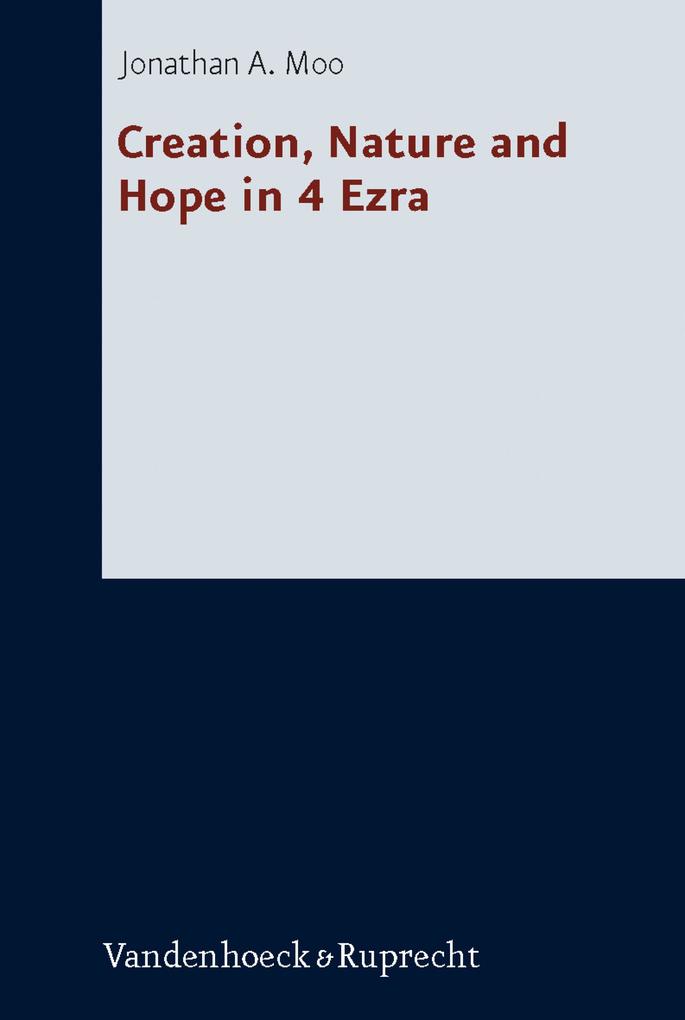
Sofort lieferbar (Download)
This exegetical study of creation and nature in 4 Ezra argues that this first-century Jewish apocalypse's profound pessimism concerning humankind and the present age is matched by a surprisingly robust belief in the goodness of the created order. 4 Ezra presents the natural world as standing with God over and against corrupt humankind, envisions substantial elements of continuity between the ages and hints that those parts of the earth that remain unsullied by humankind still witness to God's sovereignty, love and justice and even serve as material pointers to the new creation. This study calls into question the persistent assumption that apocalypticism and the 'apocalyptic eschatology' of the historical apocalypses in particular necessarily entails a profound dualism. Emerging as it does from an experience of historical disaster and unresolved questions of theodicy, 4 Ezra especially is often considered an apocalypse in which the doctrine of the two ages has been radicalised to the extent that creation, history and life in this world have lost their meaning or significance. The results of this study, however, indicate that while 4 Ezra considers the world of humankind to be corrupted and corrupting, in the natural world the creator's sovereignty is not so obscured, and there his original intentions for creation can still be perceived. This study provides a fresh reading of 4 Ezra that takes seriously the book's unity and coherence. Its conclusions suggest that it may be best to abandon the label 'apocalyptic eschatology' given its potential mask the interesting complexities and mix of continuity and discontinuity that attend the portrayal of creation, nature and hope in an apocalypse like 4 Ezra.
Inhaltsverzeichnis
1;Front Cover;1 2;Title Page;4 3;Copyright;5 4;Table of Contents;6 5;Body;8 6;Preface;8 7;1. Creation, the Apocalyptic Outlook and 4 Ezra;10 7.1;1.1 Introduction;10 7.2;1.2 Creation, History and Apocalypse;11 7.3;1.3 The Apocalyptic Outlook and 4 Ezra;19 7.4;1.4 Situating the Present Study;22 7.5;1.5 Format of the Study;25 8;2. Hearing the Voice of 4 Ezra;28 8.1;2.1 Language and Text;28 8.2;2.2 Overview of the Book;30 8.3;2.3 Unity, Coherence and Finding the Authors Voice;31 9;3. Creation in the Beginning;36 9.1;3.1 Introduction;36 9.2;3.2 The Vocabulary of Creation;36 9.3;3.3 Adam and the Garden (3:46);38 9.4;3.4 Creation and Judgement (6:16);46 9.5;3.5 Genesis Rewritten (6:3854);59 9.6;3.6 Conclusions;69 10;4. Creation Now: A World in Peril;72 10.1;4.1 Introduction;72 10.2;4.2 The Created Order and a Universal Law;72 10.3;4.3 The Parabolic Use of the Natural Order;83 10.4;4.4 Natural Law Rejected?;86 10.5;4.5 A Threatened World;88 10.6;4.6 A Threatening World;93 10.7;4.7 Two Worlds Planned from the Beginning ;97 10.8;4.8 This Aging Saeculum;100 10.9;4.9 Creations Plight: Some Conclusions;102 11;5. The Saeculum to Come;106 11.1;5.1 Introduction;106 11.2;5.2 Episode 1;107 11.2.1;5.2.1 Intimations of an end;107 11.2.2;5.2.2 Reasons for an end;108 11.2.3;5.2.3 Signs of the end (I);112 11.3;5.3 Episode 2;116 11.3.1;5.3.1 A predetermined end;116 11.3.2;5.3.2 Dividing the ages;117 11.3.3;5.3.3 Signs of the end (II);120 11.4;5.4 Episode 3;125 11.4.1;5.4.1 Ways of the world to come;125 11.4.2;5.4.2 The eschatological framework;126 11.4.3;5.4.3 The renewal of creation;136 11.4.4;5.4.4 The immortal age;137 11.4.5;5.4.5 Eschatological rewards;138 11.4.6;5.4.6 Signs of the end (III);141 11.5;5.5 Episode 4;143 11.5.1;5.5.1 A heavenly and earthly city;143 11.5.2;5.5.2 Mother Zion and Mother Earth;145 11.5.3;5.5.3 Eating the flowers of the field;146 11.6;5.6 Episodes 5 and 6;149 11.6.1;5.6.1 The deliverance of creation;150 11.6.2;5.6.2 Another land;153 11.7;5.7 Episode 7;154 11.8
;5.8 Conclusions: Ambiguity, Discontinuity and Hope;158 12;6. Summary and Conclusions;162 12.1;6.1 Summary of Results;162 12.2;6.2 Fourth Ezras Theology of Creation, the Apocalyptic Tradition and Prospects for Future Research;165 13;Bibliography;174 14;Index;192 15;Back Cover;210
;5.8 Conclusions: Ambiguity, Discontinuity and Hope;158 12;6. Summary and Conclusions;162 12.1;6.1 Summary of Results;162 12.2;6.2 Fourth Ezras Theology of Creation, the Apocalyptic Tradition and Prospects for Future Research;165 13;Bibliography;174 14;Index;192 15;Back Cover;210
Produktdetails
Erscheinungsdatum
18. Mai 2011
Sprache
englisch
Seitenanzahl
206
Dateigröße
1,37 MB
Reihe
Forschungen zur Religion und Literatur des Alten und Neuen Testaments
Autor/Autorin
Jonathan A. Moo
Herausgegeben von
Dietrich-Alex Koch
Verlag/Hersteller
Kopierschutz
ohne Kopierschutz
Family Sharing
Ja
Produktart
EBOOK
Dateiformat
PDF
ISBN
9783647531038
Entdecken Sie mehr
Bewertungen
0 Bewertungen
Es wurden noch keine Bewertungen abgegeben. Schreiben Sie die erste Bewertung zu "Creation, Nature and Hope in 4 Ezra" und helfen Sie damit anderen bei der Kaufentscheidung.







